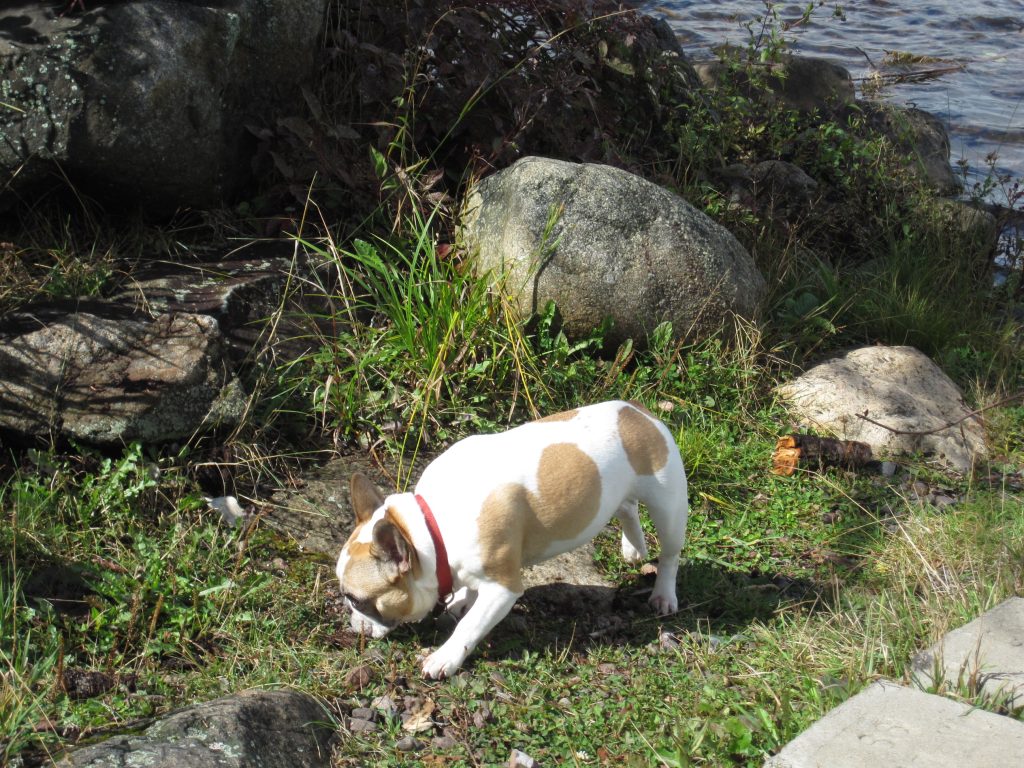You’d think that since I’m president of a one-person company, I could change anything in my office in a snap. But a recent incident reminded me that top-down change is always a process.
My dog, Miss Pudge, comes to the office with me every day. Until recently, she spent her day on a blanket by the door where she chewed her on her bone between naps. When she wasn’t chewing or napping, she tugged the blanket around the floor. But this day, I’d stepped on the blanket and slipped one too many times—and frankly, the blanket was looking ratty!
So, I decided to replace it.
Lesson 1: A change usually represents someone’s best idea on how to solve a problem or respond to an external event.
I decided that a cushy new dog bed would solve several problems at once. It would stay in one place, look better, and provide a more comfortable nest for Miss Pudge.
That’s usually the case with a top-down change. Someone is offering the best solution they know at the time to improve the situation. No matter what it looks like from below, people who initiate change hope and intend to improve the situation. But unless managers follow the rest of these lessons, it’s unlikely that the people who are asked to change will appreciate this truth.
Lesson 2: One person’s carefully considered idea is another person’s incomprehensible surprise.
When the new dog bed arrived, Pudge was curious about the box. She was even curious about its contents. But when I replaced her old blanket with the new bed, her curiosity ended. She picked up her bone and headed into the hall for a good chew. Then, one by one, she moved the rest of her toys out into the hall.
The people charged with formulating new strategies spend time thinking through the issues, economics, benefits, and risks. By the time they decide to implement a change, they have a thorough understanding. They’ve worked through questions, risks, and their own objections. And then they forget that other people have not had as much time to mull over the issues and examine the pros, cons, and imperatives.
It is very important for people to understand the thinking behind a change. They need information and time to digest it.
Lesson 3: The people seeking a change may value different things than the people expected to change.
When I bought a new dog bed, I was looking for neatness, containment, and easy washing. Although Pudge can’t tell me, I suspect that she valued the ability to tug the blanket around and actually enjoy its odor (she’s a dog, after all!).
When a mid-western company was purchased by a larger firm based in New York, headquarters assumed that the acquired company would appreciate new opportunities for advancement and travel. They were sure the mid-westerners would find their direct approach a breath of fresh air. But the mid-westerners valued balancing work and family life. The mid-westerners believed that being considerate was part of maintaining long-term working relationships. To them, the New Yorkers’ directness seemed disrespectful and rude.
People who ask others to change may not understand what value they are asking people to give up. And in fact, they may not appreciate or even notice what’s valuable to the people they expect to change.
Lesson 4: Change always involves loss.
I had every intention of providing something wonderful for Pudge when I bought her a new dog bed. But she didn’t see it that way. She lost her familiar blanket.
Even when there is long-term gain, the people affected by change will experience loss. They may lose established routines, patterns, and relationships. They may lose prestige, their sense of competence, or belonging. When planning a change, think about who is benefiting and who is losing as a result of the change, and then be prepared to empathize with people’s sense of loss.
Lesson 5: Choice or coercion depends on where you sit.
I chose to change my dog’s familiar blanket for a new dog bed. I didn’t consult her or offer her a choice. “She’s a dog!” you may say. That’s true. Too often, though, executives and managers treat other intelligent adults that way when it comes to organizational change.
People don’t resist change. Change presented as “Follow, or be fired!” feels like coercion. And most people resist coercion.
Along with providing information, engage the affected people in designing the change. Engagement increases support. People will still feel a sense of loss, yet they are less likely to feel like victims when they have information and some input in shaping the change. And the people closest to the work are likely to have ideas that will improve the implementation—if you bother to ask them.
Lesson 6: How people respond to a change is a rich source of information.
When people don’t do what we want them to do, change management professionals call it “resistance.” Resistance is something to overcome. If we look at it another way, how people respond to change is a source of information to refine ideas and shape implementation.
When people don’t do as we want or expect, it may be because they…
- don’t know how to do what they’re being asked to do.
- don’t feel they have time to learn the new way and still meet existing goals and targets.
- believe the existing way is better.
- don’t think the new way will work.
- believe the new way will cause harm—to customers, the company, the employees, etc.
- don’t like or don’t respect the person requesting the change.
- find the new suggestion counter-intuitive given how they believe the world works
- see that the new way runs counter to existing reward structures or other organizational systems.
Once you learn about the reasons behind “resistance,” use that information to adapt the change, provide needed training, or review potential roadblocks. Acting on the source of the response increases the chances the change will succeed.
Lesson 7: People change to retain something they value.
The second day after I introduced the new bed, Pudge followed me to the office but stopped at the door. I enticed her onto the new bed with a biscuit. She stepped gingerly onto the bed, picked up the biscuit and left. We repeated this routine for three days. Finally, after four days alone in the hall, she came into the office. She still disliked the bed, but her desire to be close to her human overweighed that.
That’s true for people, too. Most people don’t change because there’s a good argument for a change, or even when there’s overwhelming data supporting the reasons to change (witness the number of people who still smoke cigarettes). People change to retain something they value. It may be an association with people or the organization. It may be a steady paycheck. Take time to find out what people value and how the change relates to what they value.

So what does my experience with Miss Pudge and her new dog bed teach us about change? Lack of enthusiasm for a change proposal may not mean it’s a bad idea. But it indicates there’s work left to be done in introducing the idea, understanding what people value, and incorporating their ideas.








so what happend to the new dog bed in the end? Did pudge accept it after a while? (You onlty wrote she came into the office after 4 days, but nothing on the new bed)
So what is the analogy for the cookies in management?
Yes, Pudge accepted her new bed eventually. She can back to the office because she wanted to be with me. And eventually, the new bed started to feel familiar (but I suspect that it started to take on the familiar dog smell and that helped her turn the corner).
As for cookies, as with most rewards, it influenced the desired behavior short term. I could have created a real problem for myself (and the Pudge) if I’d built up the expectation that she’d get a cookie every time she stepped on to her bed, or established a precedent that she receive a cookie before she’d settle down on her bed.
Of course, change with humans is even more complex.
Heh…you could also have done what seems to be prevalent in big business; attempt various ways of making the new bed stink as badly as the old rag to attempt to lure Pudge back 😛
Sad but too often true.
Sometimes companies change surface features without addressing the underlying structures and exchanges that drive patterns. Then the old patterns reasserts themselves pretty quickly.
(I do wash Pudge’s various blankets, covers, sweaters, and beds.)
I wish I’d known you were planning this change. I could’ve recommended a good user manual:
http://www.amazon.com/Schnitzel-Krumms-Basketwork-Maclary-Friends/dp/0140555579
That is too funny!
Thanks for this, excellent analogy and example of change, change always involves loss! It gives a good insight into why the majority of us dislike change
Hi Esther,
Thanks for a great article and insight into the human mind. Myself, I’m an ALM manager and Agile/Scrum trainer. I know how difficult it is to bring people to changes (not the other way around).
The 6th lesson is a very important one; understanding the issues people may have with the change is the first key to instigating the change. Letting them be a part of the change rather than its victims is the second key (if they own it or a part of it, then it’s choice, not coercion).
Again, thanks for an excellent read,
Assaf.